Falls in Elderly: Implementation Plan for Anti-Hypertensive Medication
VerifiedAdded on 2020/05/28
|11
|2619
|55
Report
AI Summary
This report addresses the issue of falls in elderly individuals, specifically focusing on the correlation between anti-hypertensive medication and increased fall risk. The study provides a comprehensive overview, starting with an introduction that highlights the prevalence of hypertension in older adults and the subsequent use of medications to manage it. It delves into the background, emphasizing the need to understand why these medications, while beneficial for hypertension, contribute to falls. The report outlines specific objectives for an implementation plan, which includes strategies such as proper use of walking aids, hip protectors, and footwear, along with programs promoting exercise, medication adjustments, and dietary considerations. The potential positive impacts of the plan, including reduced falls and injuries, improved gait, and better medication management, are discussed. Barriers like medication adherence and lack of awareness are identified, and solutions are proposed. The reflection section, based on Gibbs' reflective cycle, provides a personal account of the learning process, including the author's feelings, evaluations, and action plans. The report concludes by summarizing the findings and the importance of the implementation plan to reduce falls in the elderly, emphasizing the role of evidence-based practices and practical applications.
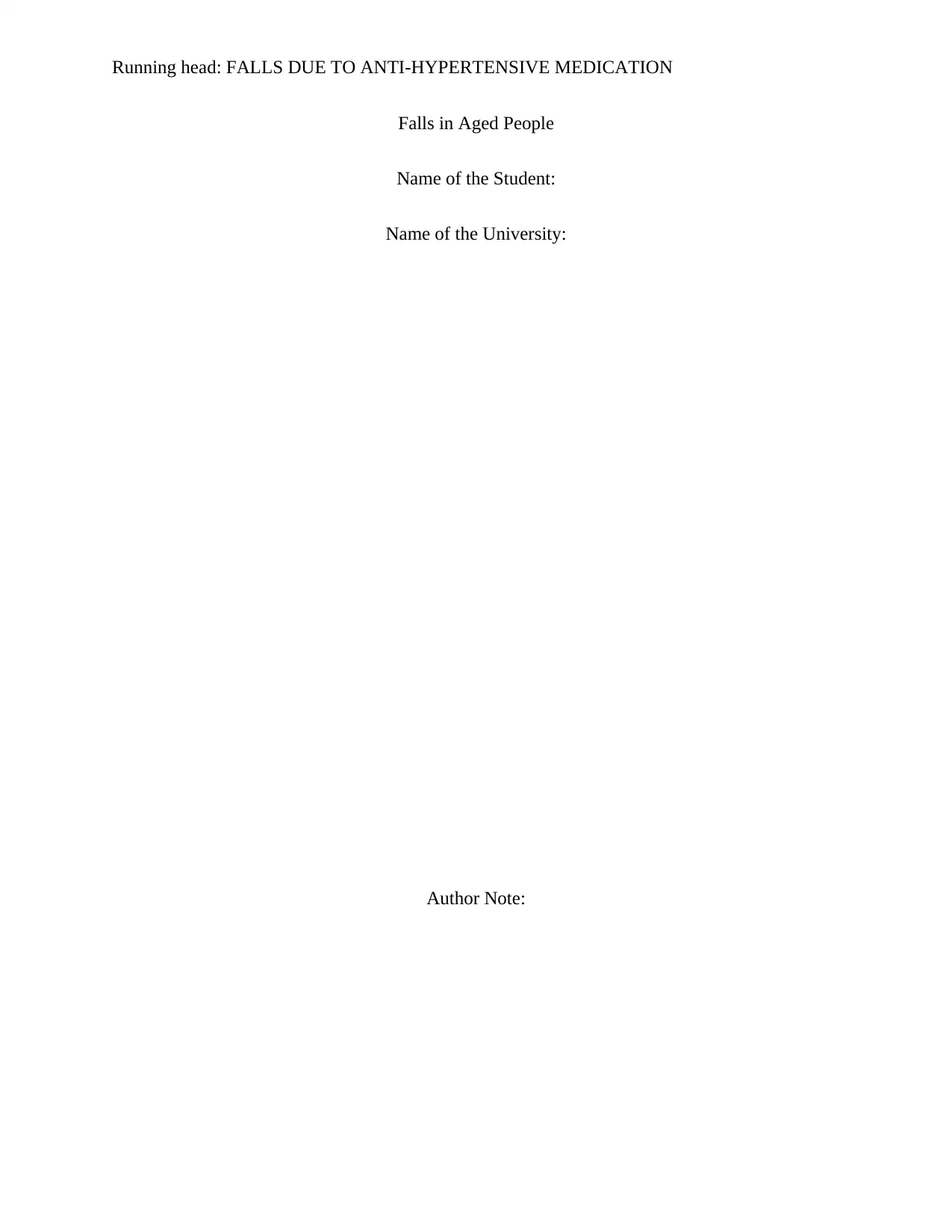
Running head: FALLS DUE TO ANTI-HYPERTENSIVE MEDICATION
Falls in Aged People
Name of the Student:
Name of the University:
Author Note:
Falls in Aged People
Name of the Student:
Name of the University:
Author Note:
Secure Best Marks with AI Grader
Need help grading? Try our AI Grader for instant feedback on your assignments.
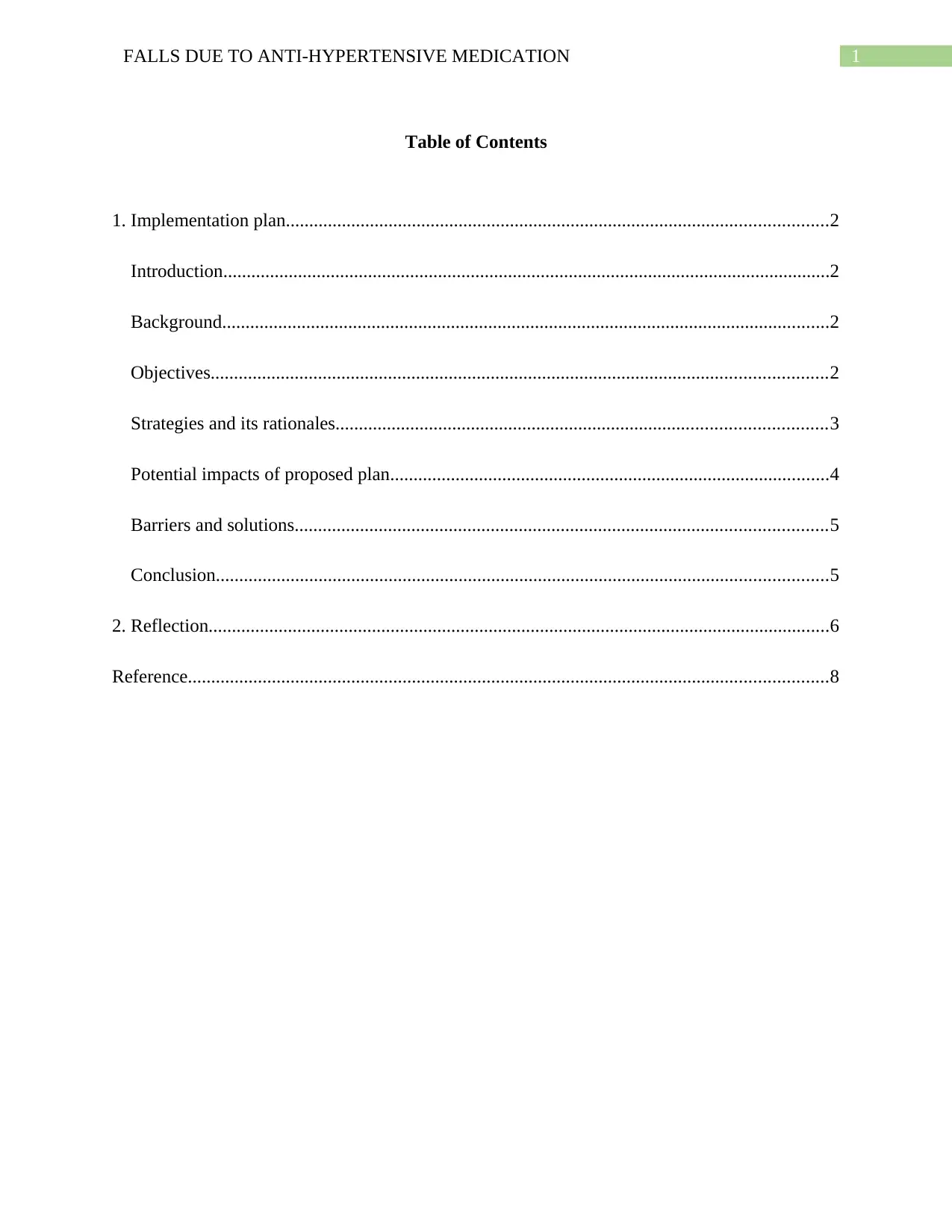
1FALLS DUE TO ANTI-HYPERTENSIVE MEDICATION
Table of Contents
1. Implementation plan....................................................................................................................2
Introduction..................................................................................................................................2
Background..................................................................................................................................2
Objectives....................................................................................................................................2
Strategies and its rationales.........................................................................................................3
Potential impacts of proposed plan..............................................................................................4
Barriers and solutions..................................................................................................................5
Conclusion...................................................................................................................................5
2. Reflection.....................................................................................................................................6
Reference.........................................................................................................................................8
Table of Contents
1. Implementation plan....................................................................................................................2
Introduction..................................................................................................................................2
Background..................................................................................................................................2
Objectives....................................................................................................................................2
Strategies and its rationales.........................................................................................................3
Potential impacts of proposed plan..............................................................................................4
Barriers and solutions..................................................................................................................5
Conclusion...................................................................................................................................5
2. Reflection.....................................................................................................................................6
Reference.........................................................................................................................................8
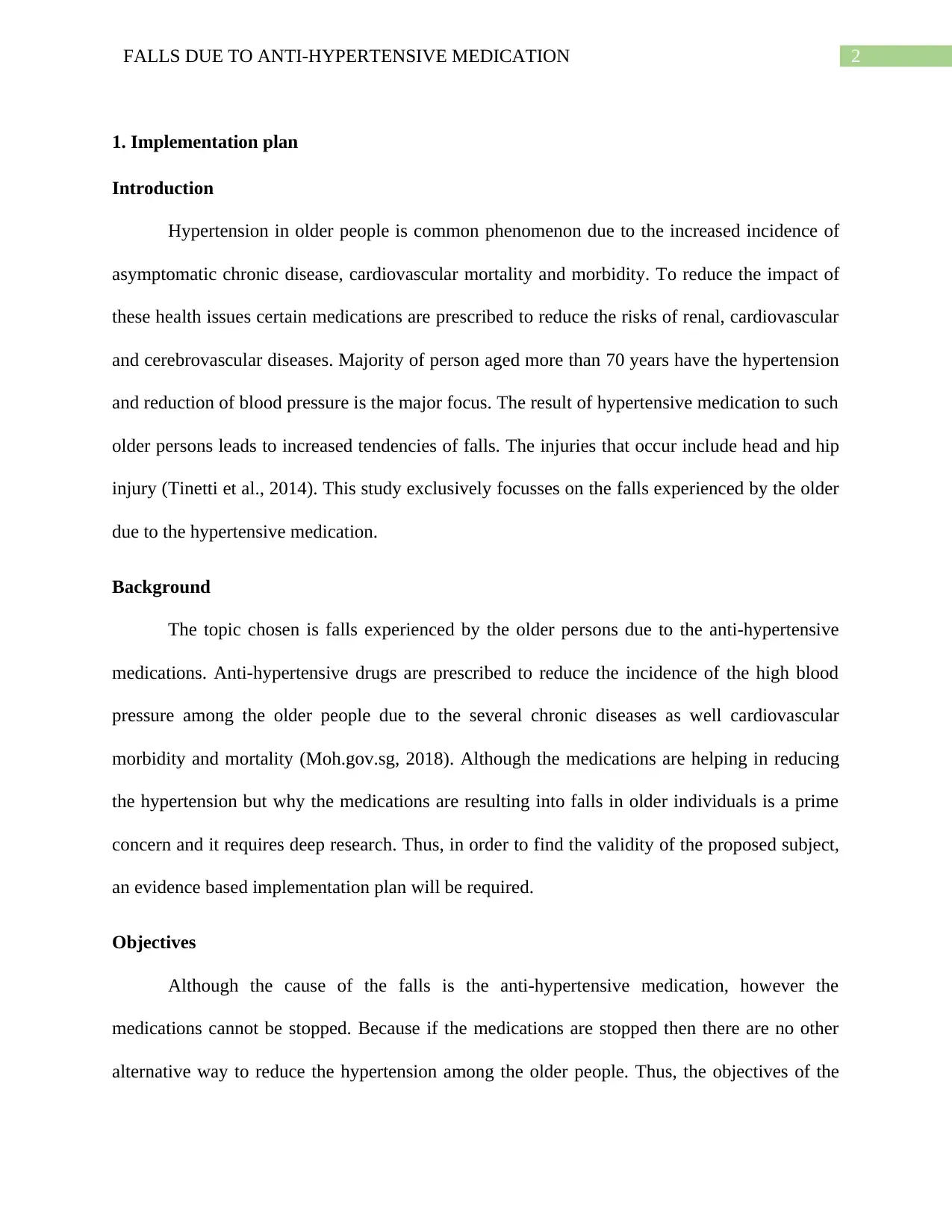
2FALLS DUE TO ANTI-HYPERTENSIVE MEDICATION
1. Implementation plan
Introduction
Hypertension in older people is common phenomenon due to the increased incidence of
asymptomatic chronic disease, cardiovascular mortality and morbidity. To reduce the impact of
these health issues certain medications are prescribed to reduce the risks of renal, cardiovascular
and cerebrovascular diseases. Majority of person aged more than 70 years have the hypertension
and reduction of blood pressure is the major focus. The result of hypertensive medication to such
older persons leads to increased tendencies of falls. The injuries that occur include head and hip
injury (Tinetti et al., 2014). This study exclusively focusses on the falls experienced by the older
due to the hypertensive medication.
Background
The topic chosen is falls experienced by the older persons due to the anti-hypertensive
medications. Anti-hypertensive drugs are prescribed to reduce the incidence of the high blood
pressure among the older people due to the several chronic diseases as well cardiovascular
morbidity and mortality (Moh.gov.sg, 2018). Although the medications are helping in reducing
the hypertension but why the medications are resulting into falls in older individuals is a prime
concern and it requires deep research. Thus, in order to find the validity of the proposed subject,
an evidence based implementation plan will be required.
Objectives
Although the cause of the falls is the anti-hypertensive medication, however the
medications cannot be stopped. Because if the medications are stopped then there are no other
alternative way to reduce the hypertension among the older people. Thus, the objectives of the
1. Implementation plan
Introduction
Hypertension in older people is common phenomenon due to the increased incidence of
asymptomatic chronic disease, cardiovascular mortality and morbidity. To reduce the impact of
these health issues certain medications are prescribed to reduce the risks of renal, cardiovascular
and cerebrovascular diseases. Majority of person aged more than 70 years have the hypertension
and reduction of blood pressure is the major focus. The result of hypertensive medication to such
older persons leads to increased tendencies of falls. The injuries that occur include head and hip
injury (Tinetti et al., 2014). This study exclusively focusses on the falls experienced by the older
due to the hypertensive medication.
Background
The topic chosen is falls experienced by the older persons due to the anti-hypertensive
medications. Anti-hypertensive drugs are prescribed to reduce the incidence of the high blood
pressure among the older people due to the several chronic diseases as well cardiovascular
morbidity and mortality (Moh.gov.sg, 2018). Although the medications are helping in reducing
the hypertension but why the medications are resulting into falls in older individuals is a prime
concern and it requires deep research. Thus, in order to find the validity of the proposed subject,
an evidence based implementation plan will be required.
Objectives
Although the cause of the falls is the anti-hypertensive medication, however the
medications cannot be stopped. Because if the medications are stopped then there are no other
alternative way to reduce the hypertension among the older people. Thus, the objectives of the
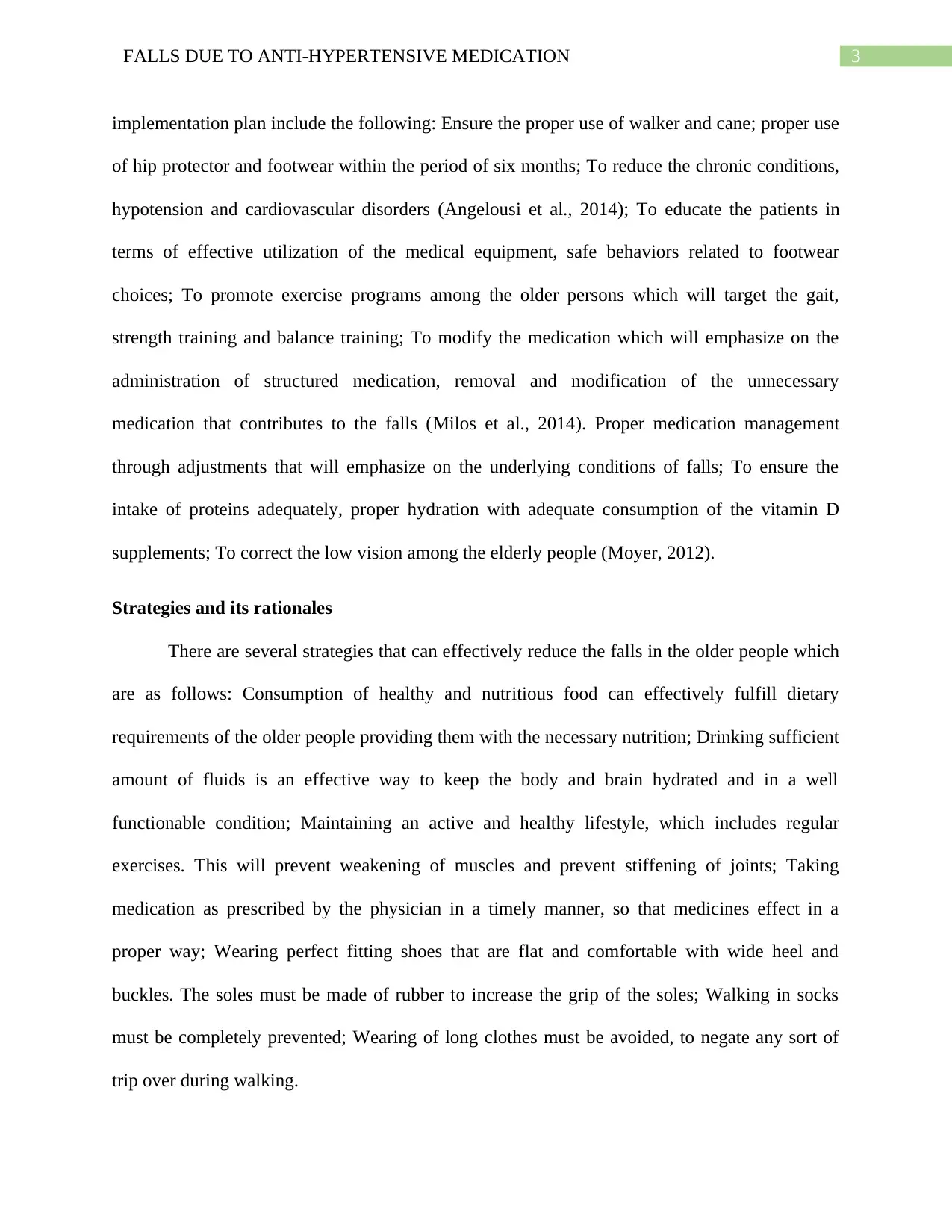
3FALLS DUE TO ANTI-HYPERTENSIVE MEDICATION
implementation plan include the following: Ensure the proper use of walker and cane; proper use
of hip protector and footwear within the period of six months; To reduce the chronic conditions,
hypotension and cardiovascular disorders (Angelousi et al., 2014); To educate the patients in
terms of effective utilization of the medical equipment, safe behaviors related to footwear
choices; To promote exercise programs among the older persons which will target the gait,
strength training and balance training; To modify the medication which will emphasize on the
administration of structured medication, removal and modification of the unnecessary
medication that contributes to the falls (Milos et al., 2014). Proper medication management
through adjustments that will emphasize on the underlying conditions of falls; To ensure the
intake of proteins adequately, proper hydration with adequate consumption of the vitamin D
supplements; To correct the low vision among the elderly people (Moyer, 2012).
Strategies and its rationales
There are several strategies that can effectively reduce the falls in the older people which
are as follows: Consumption of healthy and nutritious food can effectively fulfill dietary
requirements of the older people providing them with the necessary nutrition; Drinking sufficient
amount of fluids is an effective way to keep the body and brain hydrated and in a well
functionable condition; Maintaining an active and healthy lifestyle, which includes regular
exercises. This will prevent weakening of muscles and prevent stiffening of joints; Taking
medication as prescribed by the physician in a timely manner, so that medicines effect in a
proper way; Wearing perfect fitting shoes that are flat and comfortable with wide heel and
buckles. The soles must be made of rubber to increase the grip of the soles; Walking in socks
must be completely prevented; Wearing of long clothes must be avoided, to negate any sort of
trip over during walking.
implementation plan include the following: Ensure the proper use of walker and cane; proper use
of hip protector and footwear within the period of six months; To reduce the chronic conditions,
hypotension and cardiovascular disorders (Angelousi et al., 2014); To educate the patients in
terms of effective utilization of the medical equipment, safe behaviors related to footwear
choices; To promote exercise programs among the older persons which will target the gait,
strength training and balance training; To modify the medication which will emphasize on the
administration of structured medication, removal and modification of the unnecessary
medication that contributes to the falls (Milos et al., 2014). Proper medication management
through adjustments that will emphasize on the underlying conditions of falls; To ensure the
intake of proteins adequately, proper hydration with adequate consumption of the vitamin D
supplements; To correct the low vision among the elderly people (Moyer, 2012).
Strategies and its rationales
There are several strategies that can effectively reduce the falls in the older people which
are as follows: Consumption of healthy and nutritious food can effectively fulfill dietary
requirements of the older people providing them with the necessary nutrition; Drinking sufficient
amount of fluids is an effective way to keep the body and brain hydrated and in a well
functionable condition; Maintaining an active and healthy lifestyle, which includes regular
exercises. This will prevent weakening of muscles and prevent stiffening of joints; Taking
medication as prescribed by the physician in a timely manner, so that medicines effect in a
proper way; Wearing perfect fitting shoes that are flat and comfortable with wide heel and
buckles. The soles must be made of rubber to increase the grip of the soles; Walking in socks
must be completely prevented; Wearing of long clothes must be avoided, to negate any sort of
trip over during walking.
Secure Best Marks with AI Grader
Need help grading? Try our AI Grader for instant feedback on your assignments.
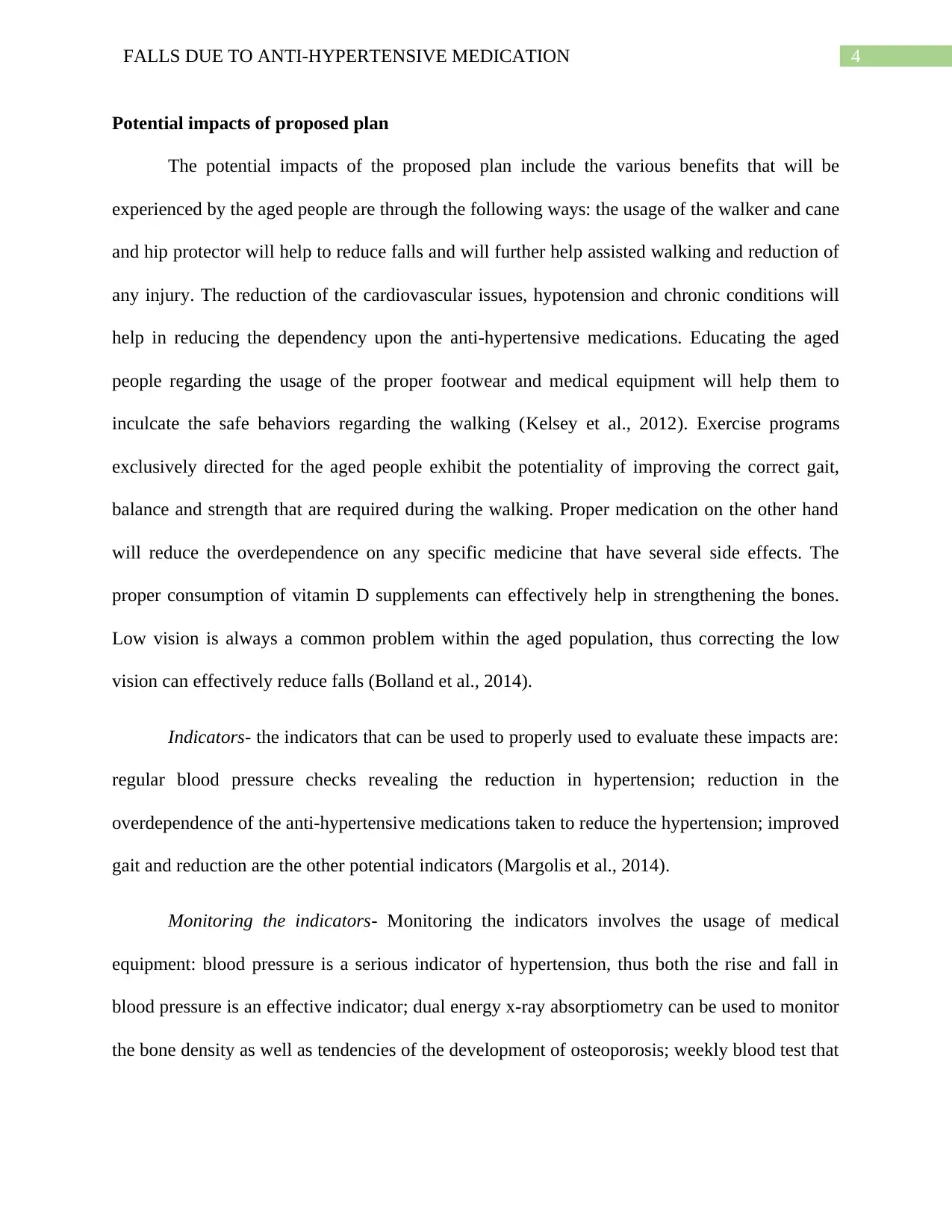
4FALLS DUE TO ANTI-HYPERTENSIVE MEDICATION
Potential impacts of proposed plan
The potential impacts of the proposed plan include the various benefits that will be
experienced by the aged people are through the following ways: the usage of the walker and cane
and hip protector will help to reduce falls and will further help assisted walking and reduction of
any injury. The reduction of the cardiovascular issues, hypotension and chronic conditions will
help in reducing the dependency upon the anti-hypertensive medications. Educating the aged
people regarding the usage of the proper footwear and medical equipment will help them to
inculcate the safe behaviors regarding the walking (Kelsey et al., 2012). Exercise programs
exclusively directed for the aged people exhibit the potentiality of improving the correct gait,
balance and strength that are required during the walking. Proper medication on the other hand
will reduce the overdependence on any specific medicine that have several side effects. The
proper consumption of vitamin D supplements can effectively help in strengthening the bones.
Low vision is always a common problem within the aged population, thus correcting the low
vision can effectively reduce falls (Bolland et al., 2014).
Indicators- the indicators that can be used to properly used to evaluate these impacts are:
regular blood pressure checks revealing the reduction in hypertension; reduction in the
overdependence of the anti-hypertensive medications taken to reduce the hypertension; improved
gait and reduction are the other potential indicators (Margolis et al., 2014).
Monitoring the indicators- Monitoring the indicators involves the usage of medical
equipment: blood pressure is a serious indicator of hypertension, thus both the rise and fall in
blood pressure is an effective indicator; dual energy x-ray absorptiometry can be used to monitor
the bone density as well as tendencies of the development of osteoporosis; weekly blood test that
Potential impacts of proposed plan
The potential impacts of the proposed plan include the various benefits that will be
experienced by the aged people are through the following ways: the usage of the walker and cane
and hip protector will help to reduce falls and will further help assisted walking and reduction of
any injury. The reduction of the cardiovascular issues, hypotension and chronic conditions will
help in reducing the dependency upon the anti-hypertensive medications. Educating the aged
people regarding the usage of the proper footwear and medical equipment will help them to
inculcate the safe behaviors regarding the walking (Kelsey et al., 2012). Exercise programs
exclusively directed for the aged people exhibit the potentiality of improving the correct gait,
balance and strength that are required during the walking. Proper medication on the other hand
will reduce the overdependence on any specific medicine that have several side effects. The
proper consumption of vitamin D supplements can effectively help in strengthening the bones.
Low vision is always a common problem within the aged population, thus correcting the low
vision can effectively reduce falls (Bolland et al., 2014).
Indicators- the indicators that can be used to properly used to evaluate these impacts are:
regular blood pressure checks revealing the reduction in hypertension; reduction in the
overdependence of the anti-hypertensive medications taken to reduce the hypertension; improved
gait and reduction are the other potential indicators (Margolis et al., 2014).
Monitoring the indicators- Monitoring the indicators involves the usage of medical
equipment: blood pressure is a serious indicator of hypertension, thus both the rise and fall in
blood pressure is an effective indicator; dual energy x-ray absorptiometry can be used to monitor
the bone density as well as tendencies of the development of osteoporosis; weekly blood test that
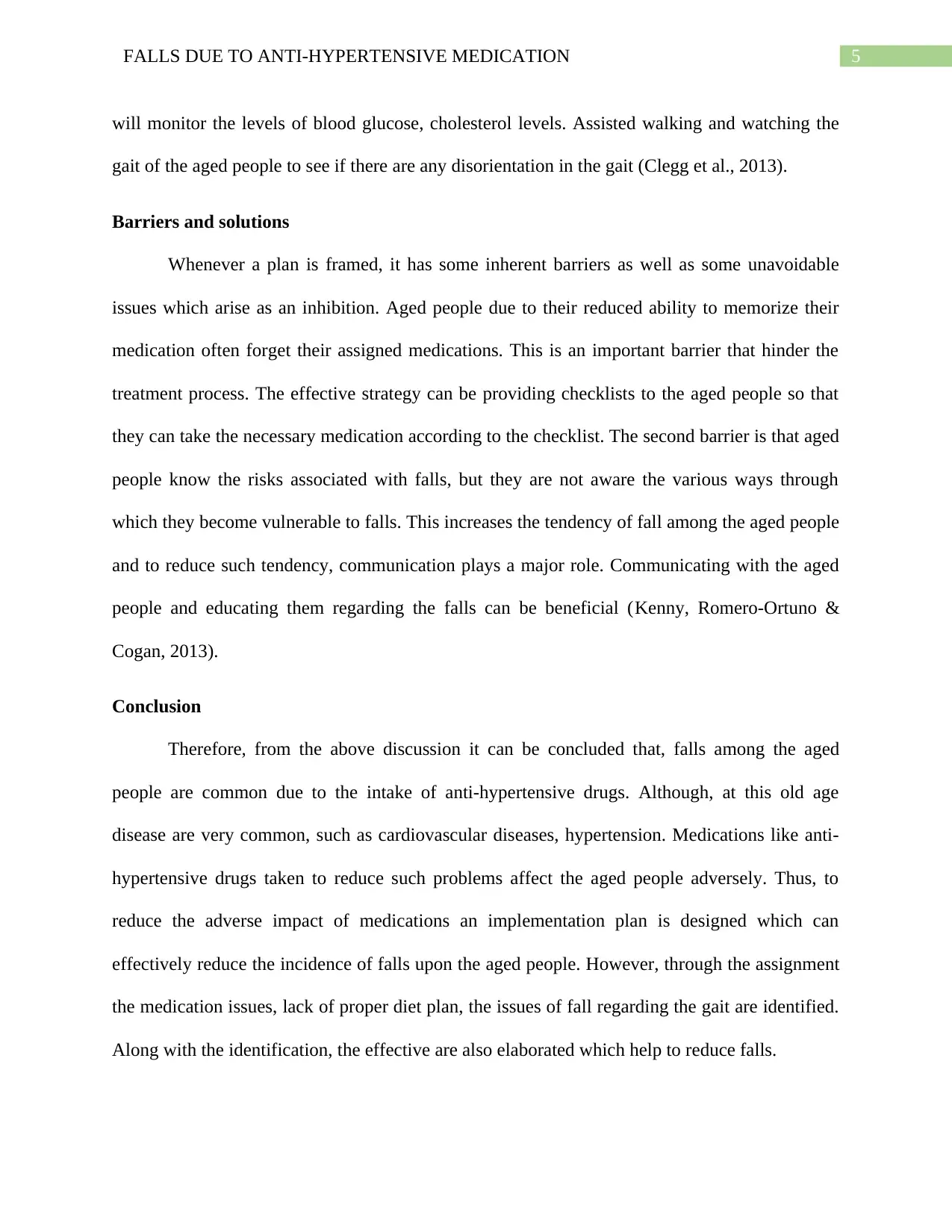
5FALLS DUE TO ANTI-HYPERTENSIVE MEDICATION
will monitor the levels of blood glucose, cholesterol levels. Assisted walking and watching the
gait of the aged people to see if there are any disorientation in the gait (Clegg et al., 2013).
Barriers and solutions
Whenever a plan is framed, it has some inherent barriers as well as some unavoidable
issues which arise as an inhibition. Aged people due to their reduced ability to memorize their
medication often forget their assigned medications. This is an important barrier that hinder the
treatment process. The effective strategy can be providing checklists to the aged people so that
they can take the necessary medication according to the checklist. The second barrier is that aged
people know the risks associated with falls, but they are not aware the various ways through
which they become vulnerable to falls. This increases the tendency of fall among the aged people
and to reduce such tendency, communication plays a major role. Communicating with the aged
people and educating them regarding the falls can be beneficial (Kenny, Romero-Ortuno &
Cogan, 2013).
Conclusion
Therefore, from the above discussion it can be concluded that, falls among the aged
people are common due to the intake of anti-hypertensive drugs. Although, at this old age
disease are very common, such as cardiovascular diseases, hypertension. Medications like anti-
hypertensive drugs taken to reduce such problems affect the aged people adversely. Thus, to
reduce the adverse impact of medications an implementation plan is designed which can
effectively reduce the incidence of falls upon the aged people. However, through the assignment
the medication issues, lack of proper diet plan, the issues of fall regarding the gait are identified.
Along with the identification, the effective are also elaborated which help to reduce falls.
will monitor the levels of blood glucose, cholesterol levels. Assisted walking and watching the
gait of the aged people to see if there are any disorientation in the gait (Clegg et al., 2013).
Barriers and solutions
Whenever a plan is framed, it has some inherent barriers as well as some unavoidable
issues which arise as an inhibition. Aged people due to their reduced ability to memorize their
medication often forget their assigned medications. This is an important barrier that hinder the
treatment process. The effective strategy can be providing checklists to the aged people so that
they can take the necessary medication according to the checklist. The second barrier is that aged
people know the risks associated with falls, but they are not aware the various ways through
which they become vulnerable to falls. This increases the tendency of fall among the aged people
and to reduce such tendency, communication plays a major role. Communicating with the aged
people and educating them regarding the falls can be beneficial (Kenny, Romero-Ortuno &
Cogan, 2013).
Conclusion
Therefore, from the above discussion it can be concluded that, falls among the aged
people are common due to the intake of anti-hypertensive drugs. Although, at this old age
disease are very common, such as cardiovascular diseases, hypertension. Medications like anti-
hypertensive drugs taken to reduce such problems affect the aged people adversely. Thus, to
reduce the adverse impact of medications an implementation plan is designed which can
effectively reduce the incidence of falls upon the aged people. However, through the assignment
the medication issues, lack of proper diet plan, the issues of fall regarding the gait are identified.
Along with the identification, the effective are also elaborated which help to reduce falls.
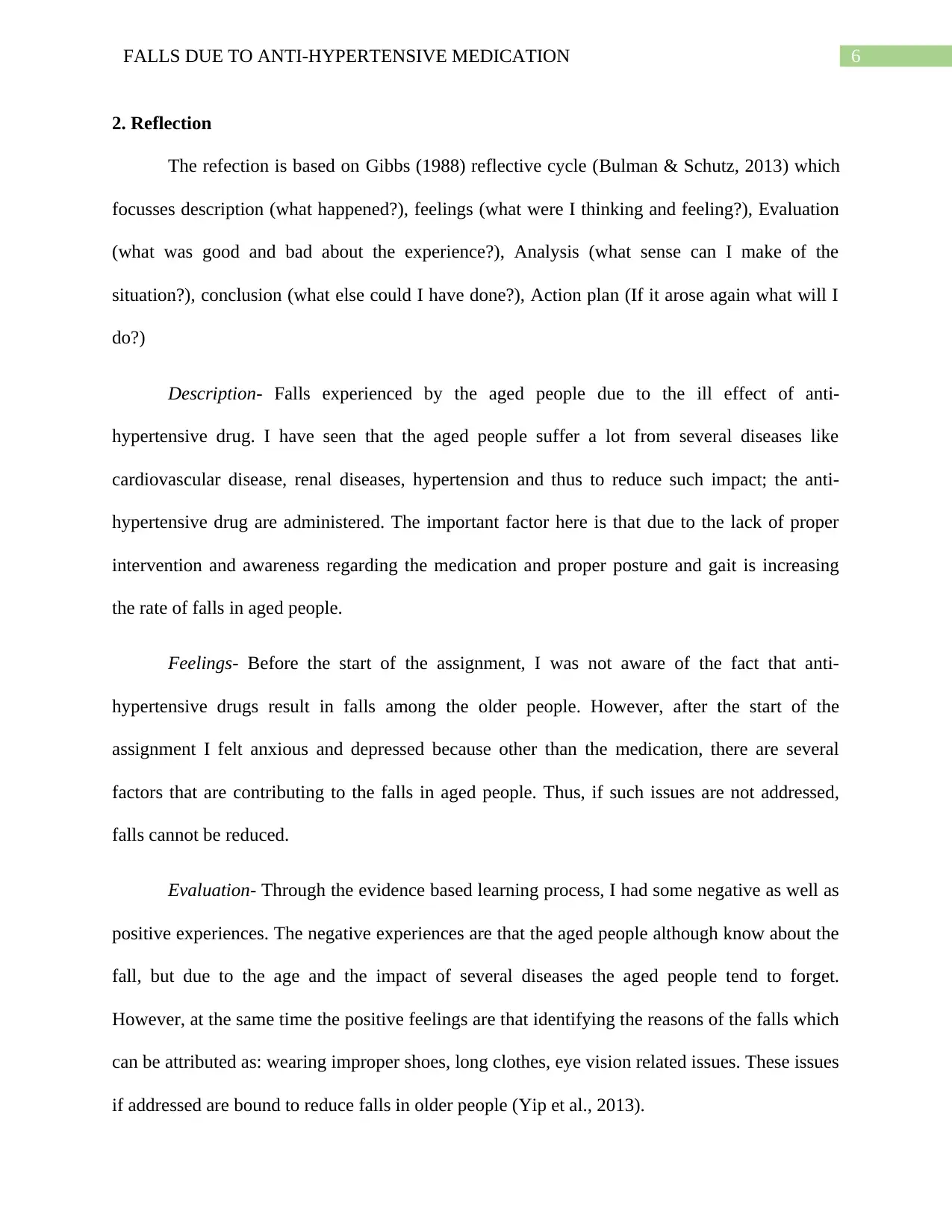
6FALLS DUE TO ANTI-HYPERTENSIVE MEDICATION
2. Reflection
The refection is based on Gibbs (1988) reflective cycle (Bulman & Schutz, 2013) which
focusses description (what happened?), feelings (what were I thinking and feeling?), Evaluation
(what was good and bad about the experience?), Analysis (what sense can I make of the
situation?), conclusion (what else could I have done?), Action plan (If it arose again what will I
do?)
Description- Falls experienced by the aged people due to the ill effect of anti-
hypertensive drug. I have seen that the aged people suffer a lot from several diseases like
cardiovascular disease, renal diseases, hypertension and thus to reduce such impact; the anti-
hypertensive drug are administered. The important factor here is that due to the lack of proper
intervention and awareness regarding the medication and proper posture and gait is increasing
the rate of falls in aged people.
Feelings- Before the start of the assignment, I was not aware of the fact that anti-
hypertensive drugs result in falls among the older people. However, after the start of the
assignment I felt anxious and depressed because other than the medication, there are several
factors that are contributing to the falls in aged people. Thus, if such issues are not addressed,
falls cannot be reduced.
Evaluation- Through the evidence based learning process, I had some negative as well as
positive experiences. The negative experiences are that the aged people although know about the
fall, but due to the age and the impact of several diseases the aged people tend to forget.
However, at the same time the positive feelings are that identifying the reasons of the falls which
can be attributed as: wearing improper shoes, long clothes, eye vision related issues. These issues
if addressed are bound to reduce falls in older people (Yip et al., 2013).
2. Reflection
The refection is based on Gibbs (1988) reflective cycle (Bulman & Schutz, 2013) which
focusses description (what happened?), feelings (what were I thinking and feeling?), Evaluation
(what was good and bad about the experience?), Analysis (what sense can I make of the
situation?), conclusion (what else could I have done?), Action plan (If it arose again what will I
do?)
Description- Falls experienced by the aged people due to the ill effect of anti-
hypertensive drug. I have seen that the aged people suffer a lot from several diseases like
cardiovascular disease, renal diseases, hypertension and thus to reduce such impact; the anti-
hypertensive drug are administered. The important factor here is that due to the lack of proper
intervention and awareness regarding the medication and proper posture and gait is increasing
the rate of falls in aged people.
Feelings- Before the start of the assignment, I was not aware of the fact that anti-
hypertensive drugs result in falls among the older people. However, after the start of the
assignment I felt anxious and depressed because other than the medication, there are several
factors that are contributing to the falls in aged people. Thus, if such issues are not addressed,
falls cannot be reduced.
Evaluation- Through the evidence based learning process, I had some negative as well as
positive experiences. The negative experiences are that the aged people although know about the
fall, but due to the age and the impact of several diseases the aged people tend to forget.
However, at the same time the positive feelings are that identifying the reasons of the falls which
can be attributed as: wearing improper shoes, long clothes, eye vision related issues. These issues
if addressed are bound to reduce falls in older people (Yip et al., 2013).
Paraphrase This Document
Need a fresh take? Get an instant paraphrase of this document with our AI Paraphraser
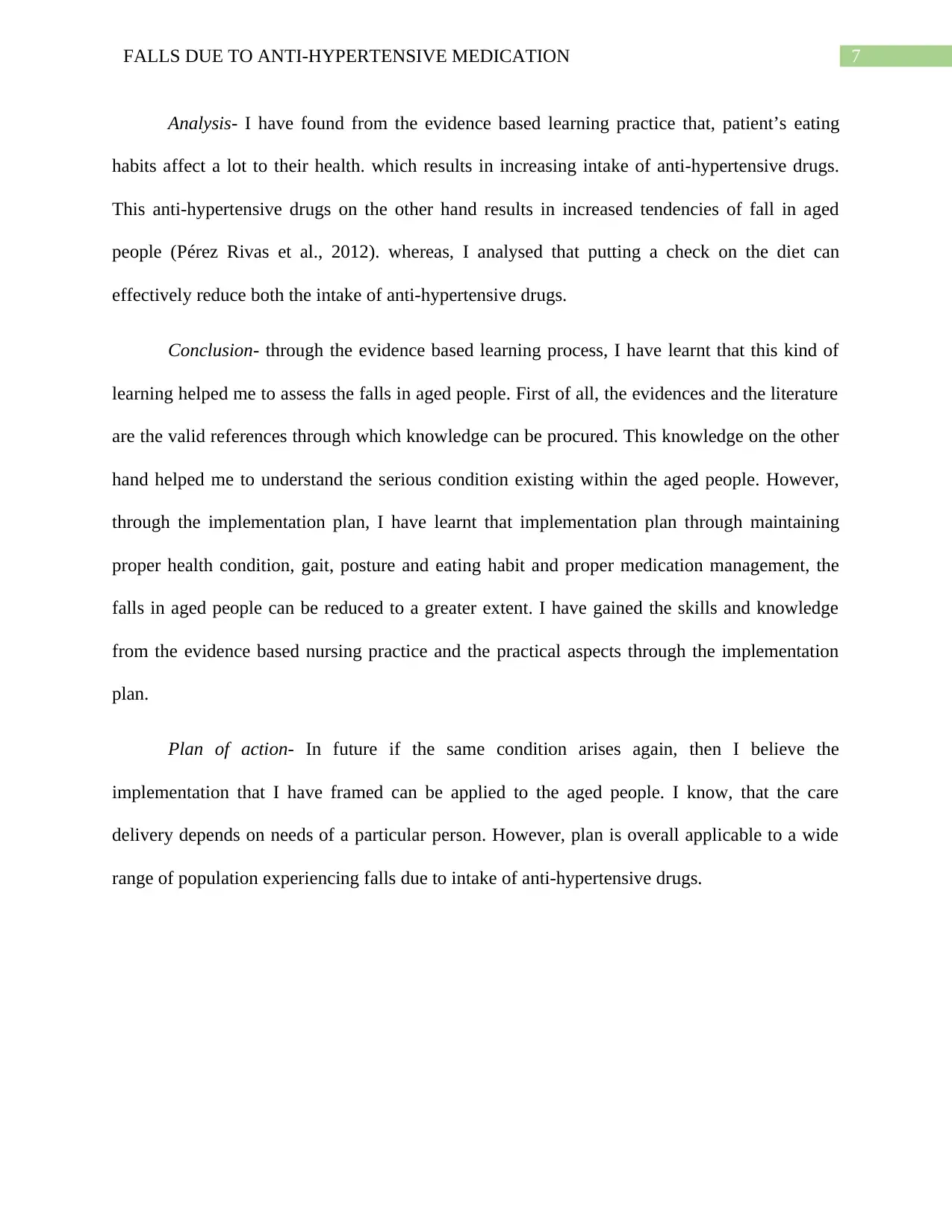
7FALLS DUE TO ANTI-HYPERTENSIVE MEDICATION
Analysis- I have found from the evidence based learning practice that, patient’s eating
habits affect a lot to their health. which results in increasing intake of anti-hypertensive drugs.
This anti-hypertensive drugs on the other hand results in increased tendencies of fall in aged
people (Pérez Rivas et al., 2012). whereas, I analysed that putting a check on the diet can
effectively reduce both the intake of anti-hypertensive drugs.
Conclusion- through the evidence based learning process, I have learnt that this kind of
learning helped me to assess the falls in aged people. First of all, the evidences and the literature
are the valid references through which knowledge can be procured. This knowledge on the other
hand helped me to understand the serious condition existing within the aged people. However,
through the implementation plan, I have learnt that implementation plan through maintaining
proper health condition, gait, posture and eating habit and proper medication management, the
falls in aged people can be reduced to a greater extent. I have gained the skills and knowledge
from the evidence based nursing practice and the practical aspects through the implementation
plan.
Plan of action- In future if the same condition arises again, then I believe the
implementation that I have framed can be applied to the aged people. I know, that the care
delivery depends on needs of a particular person. However, plan is overall applicable to a wide
range of population experiencing falls due to intake of anti-hypertensive drugs.
Analysis- I have found from the evidence based learning practice that, patient’s eating
habits affect a lot to their health. which results in increasing intake of anti-hypertensive drugs.
This anti-hypertensive drugs on the other hand results in increased tendencies of fall in aged
people (Pérez Rivas et al., 2012). whereas, I analysed that putting a check on the diet can
effectively reduce both the intake of anti-hypertensive drugs.
Conclusion- through the evidence based learning process, I have learnt that this kind of
learning helped me to assess the falls in aged people. First of all, the evidences and the literature
are the valid references through which knowledge can be procured. This knowledge on the other
hand helped me to understand the serious condition existing within the aged people. However,
through the implementation plan, I have learnt that implementation plan through maintaining
proper health condition, gait, posture and eating habit and proper medication management, the
falls in aged people can be reduced to a greater extent. I have gained the skills and knowledge
from the evidence based nursing practice and the practical aspects through the implementation
plan.
Plan of action- In future if the same condition arises again, then I believe the
implementation that I have framed can be applied to the aged people. I know, that the care
delivery depends on needs of a particular person. However, plan is overall applicable to a wide
range of population experiencing falls due to intake of anti-hypertensive drugs.
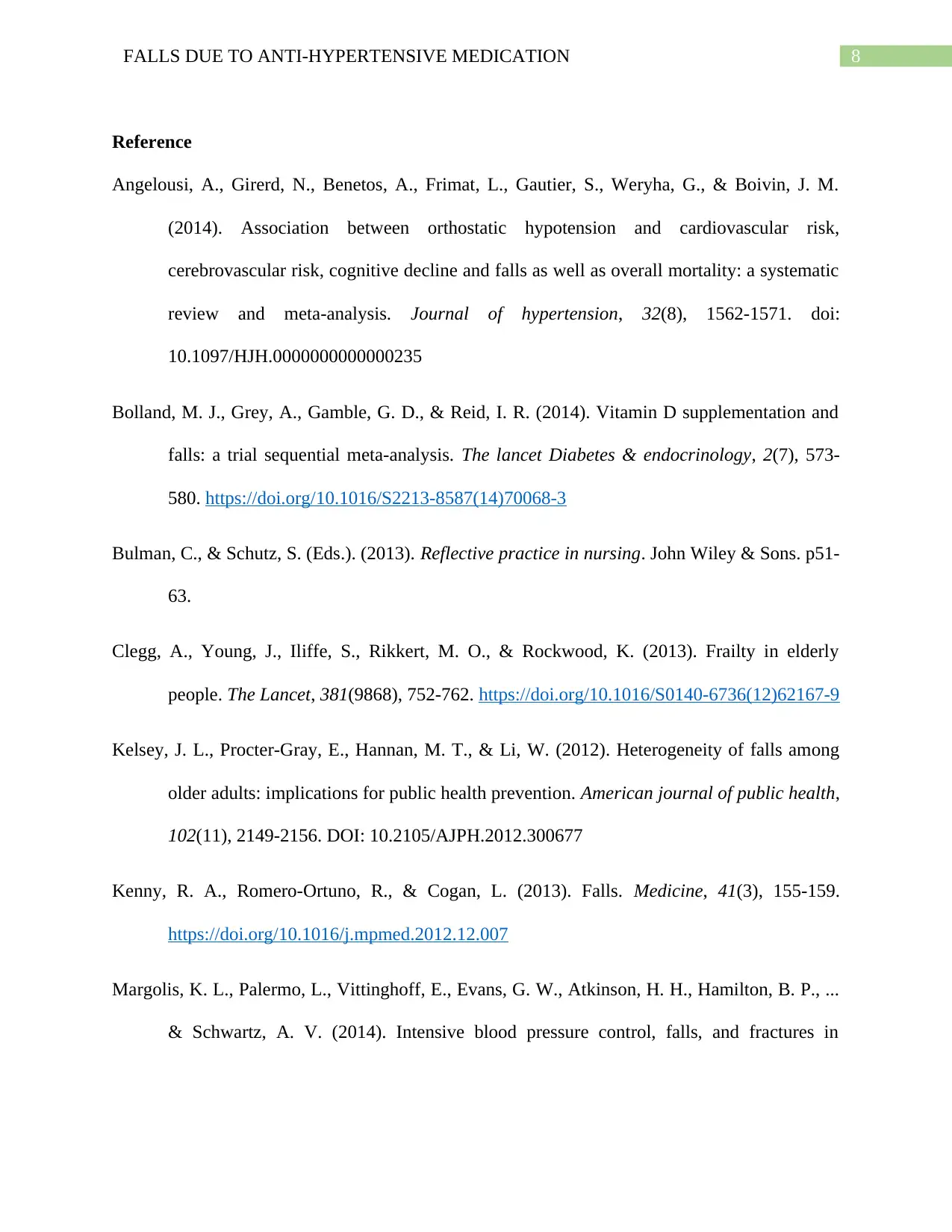
8FALLS DUE TO ANTI-HYPERTENSIVE MEDICATION
Reference
Angelousi, A., Girerd, N., Benetos, A., Frimat, L., Gautier, S., Weryha, G., & Boivin, J. M.
(2014). Association between orthostatic hypotension and cardiovascular risk,
cerebrovascular risk, cognitive decline and falls as well as overall mortality: a systematic
review and meta-analysis. Journal of hypertension, 32(8), 1562-1571. doi:
10.1097/HJH.0000000000000235
Bolland, M. J., Grey, A., Gamble, G. D., & Reid, I. R. (2014). Vitamin D supplementation and
falls: a trial sequential meta-analysis. The lancet Diabetes & endocrinology, 2(7), 573-
580. https://doi.org/10.1016/S2213-8587(14)70068-3
Bulman, C., & Schutz, S. (Eds.). (2013). Reflective practice in nursing. John Wiley & Sons. p51-
63.
Clegg, A., Young, J., Iliffe, S., Rikkert, M. O., & Rockwood, K. (2013). Frailty in elderly
people. The Lancet, 381(9868), 752-762. https://doi.org/10.1016/S0140-6736(12)62167-9
Kelsey, J. L., Procter-Gray, E., Hannan, M. T., & Li, W. (2012). Heterogeneity of falls among
older adults: implications for public health prevention. American journal of public health,
102(11), 2149-2156. DOI: 10.2105/AJPH.2012.300677
Kenny, R. A., Romero-Ortuno, R., & Cogan, L. (2013). Falls. Medicine, 41(3), 155-159.
https://doi.org/10.1016/j.mpmed.2012.12.007
Margolis, K. L., Palermo, L., Vittinghoff, E., Evans, G. W., Atkinson, H. H., Hamilton, B. P., ...
& Schwartz, A. V. (2014). Intensive blood pressure control, falls, and fractures in
Reference
Angelousi, A., Girerd, N., Benetos, A., Frimat, L., Gautier, S., Weryha, G., & Boivin, J. M.
(2014). Association between orthostatic hypotension and cardiovascular risk,
cerebrovascular risk, cognitive decline and falls as well as overall mortality: a systematic
review and meta-analysis. Journal of hypertension, 32(8), 1562-1571. doi:
10.1097/HJH.0000000000000235
Bolland, M. J., Grey, A., Gamble, G. D., & Reid, I. R. (2014). Vitamin D supplementation and
falls: a trial sequential meta-analysis. The lancet Diabetes & endocrinology, 2(7), 573-
580. https://doi.org/10.1016/S2213-8587(14)70068-3
Bulman, C., & Schutz, S. (Eds.). (2013). Reflective practice in nursing. John Wiley & Sons. p51-
63.
Clegg, A., Young, J., Iliffe, S., Rikkert, M. O., & Rockwood, K. (2013). Frailty in elderly
people. The Lancet, 381(9868), 752-762. https://doi.org/10.1016/S0140-6736(12)62167-9
Kelsey, J. L., Procter-Gray, E., Hannan, M. T., & Li, W. (2012). Heterogeneity of falls among
older adults: implications for public health prevention. American journal of public health,
102(11), 2149-2156. DOI: 10.2105/AJPH.2012.300677
Kenny, R. A., Romero-Ortuno, R., & Cogan, L. (2013). Falls. Medicine, 41(3), 155-159.
https://doi.org/10.1016/j.mpmed.2012.12.007
Margolis, K. L., Palermo, L., Vittinghoff, E., Evans, G. W., Atkinson, H. H., Hamilton, B. P., ...
& Schwartz, A. V. (2014). Intensive blood pressure control, falls, and fractures in
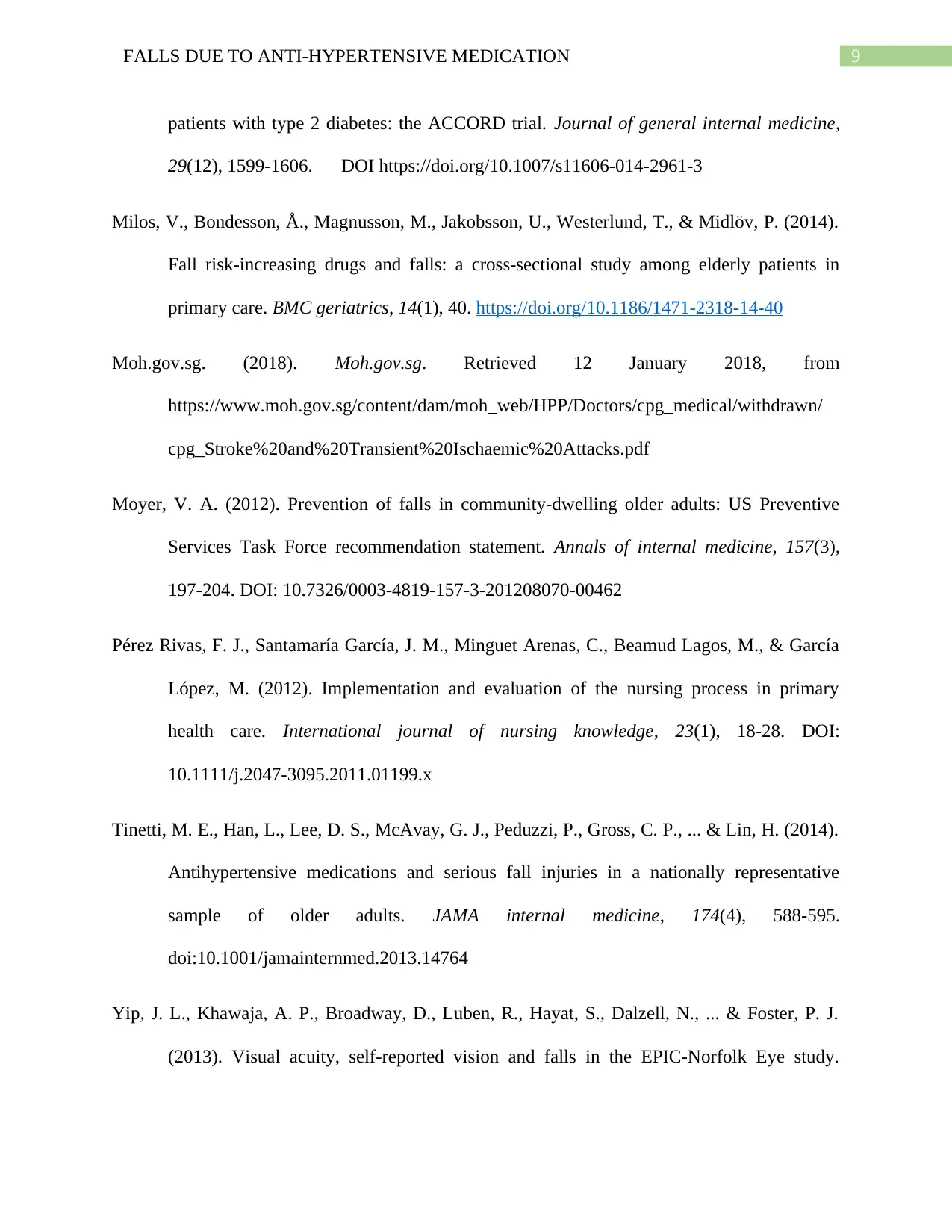
9FALLS DUE TO ANTI-HYPERTENSIVE MEDICATION
patients with type 2 diabetes: the ACCORD trial. Journal of general internal medicine,
29(12), 1599-1606. DOI https://doi.org/10.1007/s11606-014-2961-3
Milos, V., Bondesson, Å., Magnusson, M., Jakobsson, U., Westerlund, T., & Midlöv, P. (2014).
Fall risk-increasing drugs and falls: a cross-sectional study among elderly patients in
primary care. BMC geriatrics, 14(1), 40. https://doi.org/10.1186/1471-2318-14-40
Moh.gov.sg. (2018). Moh.gov.sg. Retrieved 12 January 2018, from
https://www.moh.gov.sg/content/dam/moh_web/HPP/Doctors/cpg_medical/withdrawn/
cpg_Stroke%20and%20Transient%20Ischaemic%20Attacks.pdf
Moyer, V. A. (2012). Prevention of falls in community-dwelling older adults: US Preventive
Services Task Force recommendation statement. Annals of internal medicine, 157(3),
197-204. DOI: 10.7326/0003-4819-157-3-201208070-00462
Pérez Rivas, F. J., Santamaría García, J. M., Minguet Arenas, C., Beamud Lagos, M., & García
López, M. (2012). Implementation and evaluation of the nursing process in primary
health care. International journal of nursing knowledge, 23(1), 18-28. DOI:
10.1111/j.2047-3095.2011.01199.x
Tinetti, M. E., Han, L., Lee, D. S., McAvay, G. J., Peduzzi, P., Gross, C. P., ... & Lin, H. (2014).
Antihypertensive medications and serious fall injuries in a nationally representative
sample of older adults. JAMA internal medicine, 174(4), 588-595.
doi:10.1001/jamainternmed.2013.14764
Yip, J. L., Khawaja, A. P., Broadway, D., Luben, R., Hayat, S., Dalzell, N., ... & Foster, P. J.
(2013). Visual acuity, self-reported vision and falls in the EPIC-Norfolk Eye study.
patients with type 2 diabetes: the ACCORD trial. Journal of general internal medicine,
29(12), 1599-1606. DOI https://doi.org/10.1007/s11606-014-2961-3
Milos, V., Bondesson, Å., Magnusson, M., Jakobsson, U., Westerlund, T., & Midlöv, P. (2014).
Fall risk-increasing drugs and falls: a cross-sectional study among elderly patients in
primary care. BMC geriatrics, 14(1), 40. https://doi.org/10.1186/1471-2318-14-40
Moh.gov.sg. (2018). Moh.gov.sg. Retrieved 12 January 2018, from
https://www.moh.gov.sg/content/dam/moh_web/HPP/Doctors/cpg_medical/withdrawn/
cpg_Stroke%20and%20Transient%20Ischaemic%20Attacks.pdf
Moyer, V. A. (2012). Prevention of falls in community-dwelling older adults: US Preventive
Services Task Force recommendation statement. Annals of internal medicine, 157(3),
197-204. DOI: 10.7326/0003-4819-157-3-201208070-00462
Pérez Rivas, F. J., Santamaría García, J. M., Minguet Arenas, C., Beamud Lagos, M., & García
López, M. (2012). Implementation and evaluation of the nursing process in primary
health care. International journal of nursing knowledge, 23(1), 18-28. DOI:
10.1111/j.2047-3095.2011.01199.x
Tinetti, M. E., Han, L., Lee, D. S., McAvay, G. J., Peduzzi, P., Gross, C. P., ... & Lin, H. (2014).
Antihypertensive medications and serious fall injuries in a nationally representative
sample of older adults. JAMA internal medicine, 174(4), 588-595.
doi:10.1001/jamainternmed.2013.14764
Yip, J. L., Khawaja, A. P., Broadway, D., Luben, R., Hayat, S., Dalzell, N., ... & Foster, P. J.
(2013). Visual acuity, self-reported vision and falls in the EPIC-Norfolk Eye study.
Secure Best Marks with AI Grader
Need help grading? Try our AI Grader for instant feedback on your assignments.

10FALLS DUE TO ANTI-HYPERTENSIVE MEDICATION
British journal of ophthalmology, bjophthalmol-
2013.http://dx.doi.org/10.1136/bjophthalmol-2013-304179
British journal of ophthalmology, bjophthalmol-
2013.http://dx.doi.org/10.1136/bjophthalmol-2013-304179
1 out of 11
Related Documents
Your All-in-One AI-Powered Toolkit for Academic Success.
+13062052269
info@desklib.com
Available 24*7 on WhatsApp / Email
![[object Object]](/_next/static/media/star-bottom.7253800d.svg)
Unlock your academic potential
© 2024 | Zucol Services PVT LTD | All rights reserved.





